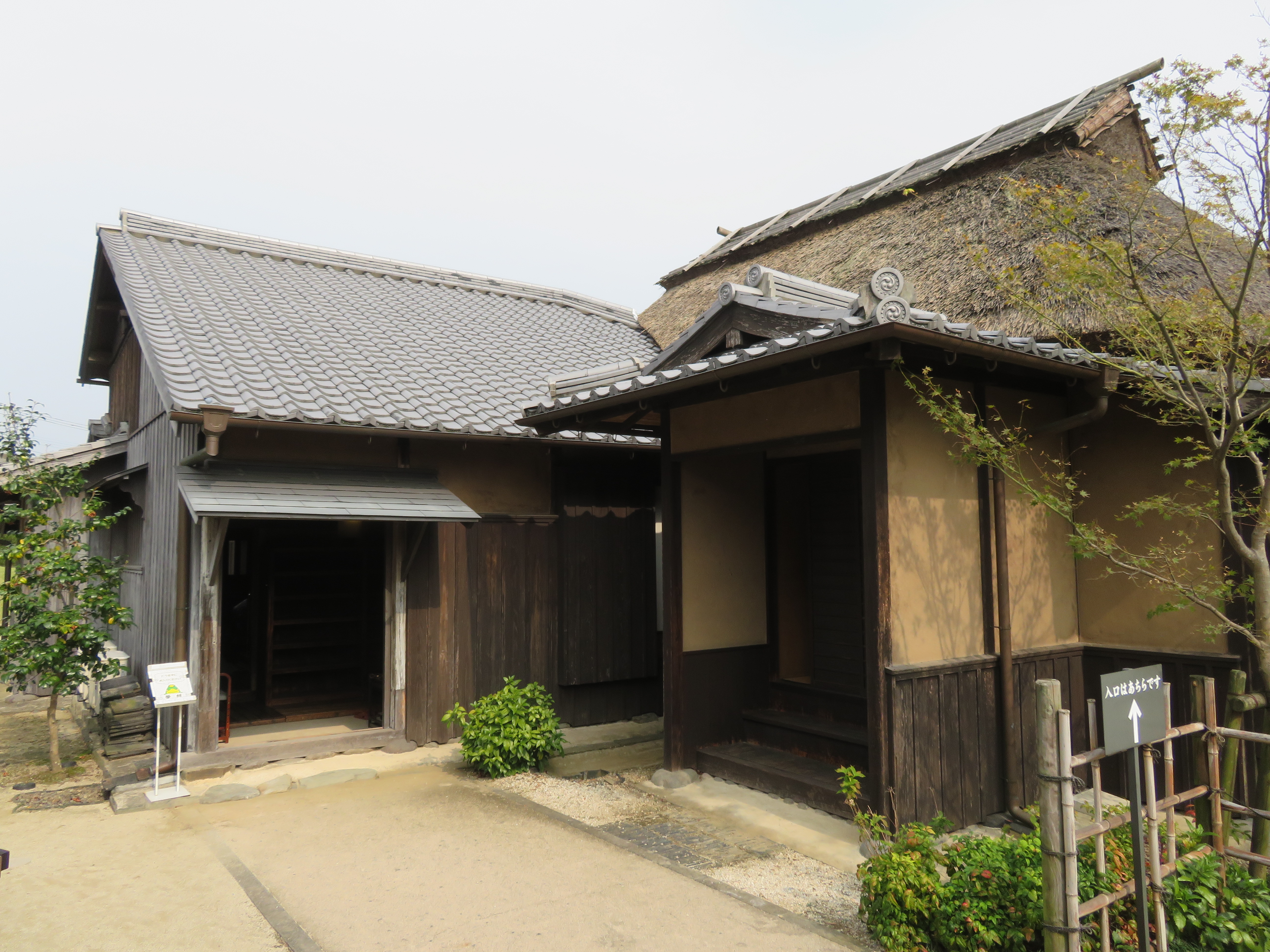Only the Honmaru stone walls remain. The Inui Gate was moved to the nearby Nichirinji temple and can still be seen today.
Updated description by ART (Jan 2024; visited 2019):
Kurume Castle's ishigaki (stone-clad ramparts) are lots of fun. There are no guide ropes or railings stopping wrong-footed visitors from tumbling over the edge, which I quite liked because peering over the lofty precipices of the ramparts allowed for even greater appreciation of their tall structure. The castle remains essentially encompass the sizable honmaru (main bailey), surrounded by ishigaki, except in the northwest where the ishigaki has fallen down, by the looks of it, due to a landslide.
In the northeast there is a yaguradai (turret platform) where the Ushitora-yagura (northeast keep) of three tiers once stood. The yaguradai doesn't seem to be in good shape: let's just say I felt nervous standing below it... The rest of the castle's ramparts seem to be mostly in decent condition, particularly in the south, which is the main entrance area of the old citadel. This area contained three of the castle's seven turrets, as well as the main gate complex with a kabukimon gate and masugata (box formation) layout beyond. The Tatsumi-yagura (southeast keep), of three tiers, was the largest keep at the castle. Here the ishigaki is double-tiered, and so it seems like it was the most heavily fortified area of Kurumejō. The east side of the yaguradai's ishigaki is bulging and may need correcting. This area below the yaguradai is sort of a secret area as it seems most visitors miss it on their way in. I came back here and found a large snail's shell and a snake.
On the way to the castle I came by two markers indicating the former second and third baileys of the castle respectively. Nichinrinji is a temple in town which was formerly relocated from what became the second baily of Kurume Castle when it was expanded in the early Edo period. The relocation of a shrine or temple is not usually worth remarking upon, but it's kind of funny that in turn, after the castle's abandonment, Kurumejō's Inuimon (northwest gate) was relocated to Nichirinji, becoming the temple's sanmon (main gate)! I visited Nichirinji to see the gate after going to the Sakamoto-bukeyashiki, the last remaining samurai house in Kurume.
Kurumejō is favoured geographically, being located on a small hilltop (Sasayama) with the Chikugo River running behind it. This makes Kurumejō a hirayama-type castle: specifically it is built in the Hirayama-Tamon style. The main bailey possessed, in addition to the lord's palace, seven yagura of two or three tiers connected by tamon-yagura (hallway turrets). The castle's keeps consisted of the Tatsumi-yagura (southeast), the largest keep of three tiers; the Ushitora-yagura (northeast) of three tiers; the Inui-yagura (northwest) of three tiers; the Hitsujisaru-yagura (southwest) of three tiers; Taiko-yagura (drum tower) of three tiers to the left of the kabukimon; the Nishishita-yagura in the west of the honmaru; and the Fushimi-yagura next to the eastern gate.
Loading map...
{"format":"leaflet","minzoom":false,"maxzoom":false,"limit":500,"offset":0,"link":"all","sort":["order"],"order":[],"headers":"show","mainlabel":"","intro":"","outro":"","searchlabel":"... further results","default":"","import-annotation":false,"width":"auto","height":"350px","centre":false,"title":"","label":"","icon":"Darkred18.png","lines":[],"polygons":[],"circles":[],"rectangles":[],"copycoords":false,"static":false,"zoom":false,"defzoom":14,"layers":["Esri.WorldTopoMap"],"image layers":[],"overlays":[],"resizable":false,"fullscreen":false,"scrollwheelzoom":true,"cluster":false,"clustermaxzoom":20,"clusterzoomonclick":true,"clustermaxradius":80,"clusterspiderfy":true,"geojson":"","clicktarget":"","showtitle":false,"hidenamespace":true,"template":"InfoWindowProfile","userparam":"","activeicon":"","pagelabel":false,"ajaxcoordproperty":"","ajaxquery":"","locations":[{"text":"\u003Cdiv style=\"width:150px\"\u003E\n\u003Cp\u003E\u003Ca href=\"/view/File:KurumejouART_(32).jpg\" class=\"image\"\u003E\u003Cimg alt=\"KurumejouART (32).jpg\" src=\"../images/thumb/2/22/KurumejouART_%2832%29.jpg/125px-KurumejouART_%2832%29.jpg\" decoding=\"async\" width=\"125\" height=\"94\" srcset=\"../images/thumb/2/22/KurumejouART_%2832%29.jpg/188px-KurumejouART_%2832%29.jpg 1.5x, ../images/thumb/2/22/KurumejouART_%2832%29.jpg/250px-KurumejouART_%2832%29.jpg 2x\" /\u003E\u003C/a\u003E\n\u003C/p\u003E\n\u003C/div\u003E","title":"","link":"","lat":33.32777,"lon":130.50809,"icon":"../images/0/06/Darkred18.png"},{"text":"\u003Cdiv style=\"width:150px\"\u003E\n\u003Cp\u003E\u003Ca href=\"/view/File:KurumejouART_(11).jpg\" class=\"image\"\u003E\u003Cimg alt=\"KurumejouART (11).jpg\" src=\"../images/thumb/5/5f/KurumejouART_%2811%29.jpg/125px-KurumejouART_%2811%29.jpg\" decoding=\"async\" width=\"125\" height=\"94\" srcset=\"../images/thumb/5/5f/KurumejouART_%2811%29.jpg/188px-KurumejouART_%2811%29.jpg 1.5x, ../images/thumb/5/5f/KurumejouART_%2811%29.jpg/250px-KurumejouART_%2811%29.jpg 2x\" /\u003E\u003C/a\u003E\n\u003C/p\u003E\n\u003C/div\u003E","title":"","link":"","lat":33.32789,"lon":130.50692,"icon":"../images/0/06/Darkred18.png"},{"text":"\u003Cdiv style=\"width:150px\"\u003E\n\u003Cp\u003E\u003Ca href=\"/view/File:KurumejouART_(2).jpg\" class=\"image\"\u003E\u003Cimg alt=\"KurumejouART (2).jpg\" src=\"../images/thumb/3/3d/KurumejouART_%282%29.jpg/125px-KurumejouART_%282%29.jpg\" decoding=\"async\" width=\"125\" height=\"94\" srcset=\"../images/thumb/3/3d/KurumejouART_%282%29.jpg/188px-KurumejouART_%282%29.jpg 1.5x, ../images/thumb/3/3d/KurumejouART_%282%29.jpg/250px-KurumejouART_%282%29.jpg 2x\" /\u003E\u003C/a\u003E\n\u003C/p\u003E\n\u003C/div\u003E","title":"","link":"","lat":33.32827,"lon":130.50841,"icon":"../images/0/06/Darkred18.png"},{"text":"\u003Cdiv style=\"width:150px\"\u003E\n\u003Cp\u003E\u003Ca href=\"/view/File:KurumejouART_(42).jpg\" class=\"image\"\u003E\u003Cimg alt=\"KurumejouART (42).jpg\" src=\"../images/thumb/3/3c/KurumejouART_%2842%29.jpg/125px-KurumejouART_%2842%29.jpg\" decoding=\"async\" width=\"125\" height=\"94\" srcset=\"../images/thumb/3/3c/KurumejouART_%2842%29.jpg/188px-KurumejouART_%2842%29.jpg 1.5x, ../images/thumb/3/3c/KurumejouART_%2842%29.jpg/250px-KurumejouART_%2842%29.jpg 2x\" /\u003E\u003C/a\u003E\n\u003C/p\u003E\n\u003C/div\u003E","title":"","link":"","lat":33.3278,"lon":130.50816,"icon":"../images/0/06/Darkred18.png"},{"text":"\u003Cdiv style=\"width:150px\"\u003E\n\u003Cp\u003E\u003Ca href=\"/view/File:KurumejouART_(14).jpg\" class=\"image\"\u003E\u003Cimg alt=\"KurumejouART (14).jpg\" src=\"../images/thumb/6/6c/KurumejouART_%2814%29.jpg/125px-KurumejouART_%2814%29.jpg\" decoding=\"async\" width=\"125\" height=\"94\" srcset=\"../images/thumb/6/6c/KurumejouART_%2814%29.jpg/188px-KurumejouART_%2814%29.jpg 1.5x, ../images/thumb/6/6c/KurumejouART_%2814%29.jpg/250px-KurumejouART_%2814%29.jpg 2x\" /\u003E\u003C/a\u003E\n\u003C/p\u003E\n\u003C/div\u003E","title":"","link":"","lat":33.32799,"lon":130.50633,"icon":"../images/0/06/Darkred18.png"},{"text":"\u003Cdiv style=\"width:150px\"\u003E\n\u003Cp\u003E\u003Ca href=\"/view/File:KurumejouART_(10).jpg\" class=\"image\"\u003E\u003Cimg alt=\"KurumejouART (10).jpg\" src=\"../images/thumb/3/34/KurumejouART_%2810%29.jpg/125px-KurumejouART_%2810%29.jpg\" decoding=\"async\" width=\"125\" height=\"94\" srcset=\"../images/thumb/3/34/KurumejouART_%2810%29.jpg/188px-KurumejouART_%2810%29.jpg 1.5x, ../images/thumb/3/34/KurumejouART_%2810%29.jpg/250px-KurumejouART_%2810%29.jpg 2x\" /\u003E\u003C/a\u003E\n\u003C/p\u003E\n\u003C/div\u003E","title":"","link":"","lat":33.32627,"lon":130.50731,"icon":"../images/0/06/Darkred18.png"},{"text":"\u003Cdiv style=\"width:150px\"\u003E\n\u003Cp\u003E\u003Ca href=\"/view/File:KurumejouART_(9).jpg\" class=\"image\"\u003E\u003Cimg alt=\"KurumejouART (9).jpg\" src=\"../images/thumb/5/5e/KurumejouART_%289%29.jpg/125px-KurumejouART_%289%29.jpg\" decoding=\"async\" width=\"125\" height=\"94\" srcset=\"../images/thumb/5/5e/KurumejouART_%289%29.jpg/188px-KurumejouART_%289%29.jpg 1.5x, ../images/thumb/5/5e/KurumejouART_%289%29.jpg/250px-KurumejouART_%289%29.jpg 2x\" /\u003E\u003C/a\u003E\n\u003C/p\u003E\n\u003C/div\u003E","title":"","link":"","lat":33.3251,"lon":130.50674,"icon":"../images/0/06/Darkred18.png"},{"text":"\u003Cdiv style=\"width:150px\"\u003E\n\u003Cp\u003E\u003Ca href=\"/view/File:KurumejouART_(62).jpg\" class=\"image\"\u003E\u003Cimg alt=\"KurumejouART (62).jpg\" src=\"../images/thumb/e/e6/KurumejouART_%2862%29.jpg/125px-KurumejouART_%2862%29.jpg\" decoding=\"async\" width=\"125\" height=\"94\" srcset=\"../images/thumb/e/e6/KurumejouART_%2862%29.jpg/188px-KurumejouART_%2862%29.jpg 1.5x, ../images/thumb/e/e6/KurumejouART_%2862%29.jpg/250px-KurumejouART_%2862%29.jpg 2x\" /\u003E\u003C/a\u003E\n\u003C/p\u003E\n\u003C/div\u003E","title":"","link":"","lat":33.32046,"lon":130.49894,"icon":"../images/0/06/Darkred18.png"},{"text":"\u003Cdiv style=\"width:150px\"\u003E\n\u003Cp\u003E\u003Ca href=\"/view/File:KurumejouART_(63).jpg\" class=\"image\"\u003E\u003Cimg alt=\"KurumejouART (63).jpg\" src=\"../images/thumb/a/ab/KurumejouART_%2863%29.jpg/125px-KurumejouART_%2863%29.jpg\" decoding=\"async\" width=\"125\" height=\"94\" srcset=\"../images/thumb/a/ab/KurumejouART_%2863%29.jpg/188px-KurumejouART_%2863%29.jpg 1.5x, ../images/thumb/a/ab/KurumejouART_%2863%29.jpg/250px-KurumejouART_%2863%29.jpg 2x\" /\u003E\u003C/a\u003E\n\u003C/p\u003E\n\u003C/div\u003E","title":"","link":"","lat":33.32047,"lon":130.49884,"icon":"../images/0/06/Darkred18.png"},{"text":"\u003Cdiv style=\"width:150px\"\u003E\n\u003Cp\u003E\u003Ca href=\"/view/File:KurumejouSakamotoBukeyashiki_(21).JPG\" class=\"image\"\u003E\u003Cimg alt=\"KurumejouSakamotoBukeyashiki (21).JPG\" src=\"../images/thumb/b/b1/KurumejouSakamotoBukeyashiki_%2821%29.JPG/125px-KurumejouSakamotoBukeyashiki_%2821%29.JPG\" decoding=\"async\" width=\"125\" height=\"94\" srcset=\"../images/thumb/b/b1/KurumejouSakamotoBukeyashiki_%2821%29.JPG/188px-KurumejouSakamotoBukeyashiki_%2821%29.JPG 1.5x, ../images/thumb/b/b1/KurumejouSakamotoBukeyashiki_%2821%29.JPG/250px-KurumejouSakamotoBukeyashiki_%2821%29.JPG 2x\" /\u003E\u003C/a\u003E\n\u003C/p\u003E\n\u003C/div\u003E","title":"","link":"","lat":33.31986,"lon":130.49914,"icon":"../images/0/06/Darkred18.png"},{"text":"\u003Cdiv style=\"width:150px\"\u003E\n\u003Cp\u003E\u003Ca href=\"/view/File:KurumejouSakamotoBukeyashiki_(29).JPG\" class=\"image\"\u003E\u003Cimg alt=\"KurumejouSakamotoBukeyashiki (29).JPG\" src=\"../images/thumb/9/9a/KurumejouSakamotoBukeyashiki_%2829%29.JPG/125px-KurumejouSakamotoBukeyashiki_%2829%29.JPG\" decoding=\"async\" width=\"125\" height=\"167\" srcset=\"../images/thumb/9/9a/KurumejouSakamotoBukeyashiki_%2829%29.JPG/188px-KurumejouSakamotoBukeyashiki_%2829%29.JPG 1.5x, ../images/thumb/9/9a/KurumejouSakamotoBukeyashiki_%2829%29.JPG/250px-KurumejouSakamotoBukeyashiki_%2829%29.JPG 2x\" /\u003E\u003C/a\u003E\n\u003C/p\u003E\n\u003C/div\u003E","title":"","link":"","lat":33.32,"lon":130.49914,"icon":"../images/0/06/Darkred18.png"}],"imageLayers":[]}


























Enable comment auto-refresher
ARTShogun
Permalink |
ARTShogun
Permalink |
ARTShogun
Permalink |
EricShogun
ARTShogun
Permalink |
ARTShogun
Permalink |